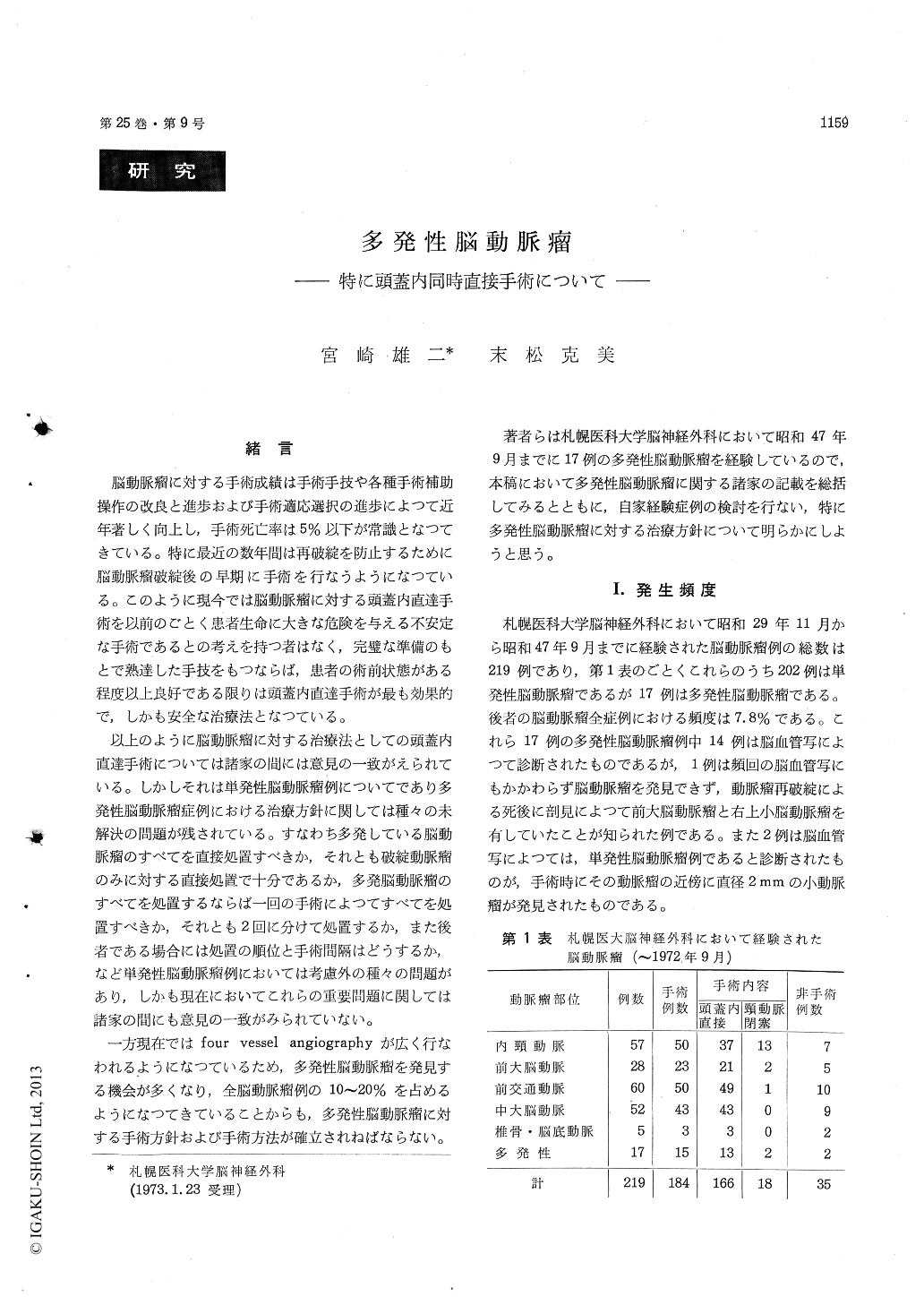Japanese
English
- 有料閲覧
- Abstract 文献概要
- 1ページ目 Look Inside
緒言
脳動脈瘤に対する手術成績は手術手技や各種手術補助操作の改良と進歩および手術適応選択の進歩によつて近年著しく向上し,手術死亡率は5%以下が常識となつてきている。特に最近の数年間は再破綻を防止するために脳動脈瘤破綻後の早期に手術を行なうようになつている。このように現今では脳動脈瘤に対する頭蓋内直達手術を以前のごとく患者生命に大きな危険を与える不安定な手術であるとの考えを持つ者はなく,完壁な準備のもとで熟達した手技をもつならば,患者の術前状態がある程度以上良好である限りは頭蓋内直達手術が最も効果的で,しかも安全な治療法となつている。
以上のように脳動脈瘤に対する治療法としての頭蓋内直達手術については諸家の間には意見の一致がえられている。しかしそれは単発性脳動脈瘤例についてであり多発性脳動脈瘤症例における治療方針に関しては種々の未解決の問題が残されている。すなわち多発している脳動脈瘤のすべてを直接処置すべきか,それとも破綻動脈瘤のみに対する直接処置で十分であるか,多発脳動脈瘤のすべてを処置するならば一回の手術によつてすべてを処置すべきか,それとも2回に分けて処置するか,また後者である場合には処置の順位と手術間隔はどうするか,など単発性脳動脈瘤例においては考慮外の種々の問題があり,しかも現在においてこれらの重要問題に関しては諸家の間にも意見の一致がみられていない。
Over the recent years in neurosurgery clinics inJapan, a definite increase in the number of cases of intracranial aneurysms are seen. In spite of the above, report on multiple intracranial aneurysms are few and hence sufficient discussions concerning the various aspects of multiple intracranial aneur-ysms have not been made. Particularly, the ab-sence of opinion regarding surgical treatment formultiple intracranial aneurysms is conspicuous.
The authors have experienced 219 cases of intra-cranial aneurysm so far, among which 17 cases were multiple intracranial aneurysms. In the pre-sent paper the authors have attempted discussions on multiple intracranial aneurysms and have also made a comprehensive study of cases of multiple intracranial aneurysms reported in the literatures hitherto.
With regard to the frequency of incidence of multiple intracranial aneurysms among intracranial aneurysms, it is a matter of course that incidence would increase when four vassel angiography is conducted. It goes without saying that values of incidence would be higher when bilateral carotid angiography is conducted as compared with unilat-eral carotid angiography. Namely, in authors' ex-perience when four vessel angiography was con-ducted multiple intracranial aneurysms was obser-ved in 11. 5 % of the cases.
The classification and combination of the various sites of intracranial aneurysm in multiple intracr-anial aneurysms must be made in such a way that it will facilitate the decision for surgical approach. Thus, the authors have suggested 4 classifications of the indivdual sites of multiple intracranial aneu-rysms in the midline and on both side of the mi dline.
Type I. Unilateral multiple intracranial aneury-sms : This type involves cases in which aneurysms are preseut in the main arteries of the internal carotid artery, the middle cerebral artery, theposterior communicating arteries or their respective branches in one side.
Type II. Bilateral multiple intracranial aneury-sms : In this type aneurysms appear symmetrically or nonsymmetrically on both sides of the midline.
Type III. Combined midline and multiple intra-cranial aneurysm : In this type multiple aneury-sms are seen in the artery running along the mid-line which is combined with either unilateral or bilateral aneurysm.
Type IV. Combined vertebro-basilar aneurysm and multiple intracranial aneurysms : This type can be type I, type II or Type III combined with ver-tebro-basilar artery aneurysm.
A detailed study was made on the paper report-ed by various authors with special regard to the opinion of treatment. With the recent improve-ment of aneurysm treatment in mind, the authors stressed the importance of direct intracranial op-eration of all multiple intracranial aneurysms in so far as it is possible. Moreover, in multiple in-tracranial aneurysms other than cases combined with vertebro-basilar aneurysm, it was clarified that as a surgical approach bifrontal craniotomy makes it possible to give the necessary treatment. It was further stressed that in oder to avoid re-rupture, even in the case of multiple intracranial aneurysms as in the case of single intracranial an-eurysm when the patient' condition is favorable in-tracranial direct operation should be conducted in the acute stage after rupture of aneurysm.

Copyright © 1973, Igaku-Shoin Ltd. All rights reserved.


